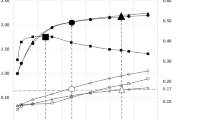Abstract
The regional cerebral blood flow, the regional blood flow distribution, and the regional distribution of perfused (=vital) brain tissue have been imaged with a digitalized conventional Anger camera. An analog scaler was placed behind the PM-tubes to reduce dead-time loss. The input pulse rate was double to counteract the effect of scaling on counting statistics, and the gamma emission was filtered through 1 mm of brass to increase the fraction of the integral count rate within the 40% window. In this way the 31 keV peak disappears, and Compton scatter and disturbing coincidences are markedly reduced. This improves spatial resolution. The flow parameters are imaged regionally in 3x3 mm2 matrix elements after flat field correction and smoothing. The matrix is 64x64 interpolated to 128x128. Patient studies emphasized the importance of imaging the distribution of perfused and nonperfused tissue in cases of infarctions, dilacerations, etc., where angiography and conventional brain scanning may often be negative.
Similar content being viewed by others
References
Dratz, A.F.: Stationary imaging devices. Continuing education lectures, Southeastern chapter, Society of Nuclear Medicine, Chapter 7 (1971)
Frigerio, N.A.: Poisson and non-poisson behaviour of radioactive systems. Nucl. Instr. and Meth. 114, 175–177 (1974)
Heiss, W.D., Prosenz, P., Roszuczky, A.: Technical consideration in the use of a gamma camera 1,600-channel analyzer system for the measurement of regional cerebral blood flow. J. nucl. Med. 13, 534–543 (1972)
Holman, B.L., Hill, R., Davis, D.O., Potchen, E.J.: Regional cerebral blood flow with the Anger camera. J. nucl. Med. 13, 916–923 (1972)
Hutten, H., Schwarz, W., Schulz, V.: Dependence of 85Kr (β)-clearance rCBF determination on the input function. Cerebral blood flow (Mainz Symposium 1969) Berlin-Heidelberg-New York: Springer 1969
Lassen, N.A.: Cerebral blood flow and oxygen consumption in man. Physiol. Rev. 39, 183–238 (1959)
Lassen, N.A.: Assessment of tissue radiation dose in clinical use of radioactive inert gases, with examples of absorbed doses from H2 3, Kr85 and Xe133 Minerva nucl. 8, 211–217 (1964)
Lassen, N.A., Ingvar, D.H.: The blood flow of the cerebral cortex determined by radioactive krypton 85. Experientia (Basel) 17, 42–43 (1961)
Lassen, N.A., Ingvar, D.H.: Radioisotopic assessment of regional cerebral blood flow. Prog. Nucl. Med. 1, 376–409 (1972)
Moll, G.: Nuclear electronics: Scaler or buffer storage for higher resolution in pulse counting equipments in radiation measurement. Kerntechnik 8, 404–406 (1966)
Muehllehner, G., Jaszczak, R.J., Beck, R.N.: The reduction of coincidence loss in radionuclide imaging cameras through the use of composite filters. Phys. in Med. Biol. 19, 504–510 (1974)
Müller, J.W.: Dead-time problems. Nucl. Instr. and Meth. 112, 47–57 (1973)
O'Brien, M.D., Veall, N.: Partition coefficients between various braintumors and blood for 133Xe. Phys. in Med. Biol. 19, 472–475 (1974)
Oldendorf, W.H.: Utilization of characteristic x-radiation to identify gamma radiation originating external to skull. J. nucl. Med. 10, 740–742 (1969)
Olesen, J.: Contralateral focal increase of cerebral blood flow in man during arm work. Brain 94, part IV, 635–646 (1971)
Reiss, K.H., Steinle, B.: Tabellen zur Röntgendiagnostik, II. Erlangen: Siemens AG 1973
Scientific tables, pp. 189–191. Basel: Ciba-Geigy Limited 1975
Sorenson, J.A.: Dead-time characteristics of Anger cameras. J. nucl. Med. 16, 284–288 (1975)
Sveinsdottir, E., Larsen, B., Rommer, P., Lassen, N.A.: A multidetector scintillation camera with 254 channels. J. nucl. Med. 18, 168–174 (1977)
Toyama, H., Lio, M., Lisaka, J., Chiba, K., Yamada, H., Matsui, K., Hoshi, Y., Fuse, M.: Color functional images of the cerebral blood flow. J. nucl. Med. 17, 953–958 (1976)
Verbist, A., Capon, A., Frühling, J.: A rapid method for evaluation of regional cerebral blood flow after intra-arterial injection of 133Xe. J. nucl. Med. 16, 264–266 (1975)
Verhas, M., Schoutens, A., Demol, O., Patte, M., Rakofsky, M., Struyven, J., Capon, A.: Use of 99mTc-labelled albumin microspheres in cerebral vascular disease. J. nucl. Med. 17, 170–174 (1976)
Wellman, H.N., Kereiakes, J.G., Yeager, T.B., Karches, G.J., Saenger, E.L.: A sensitive technique for measuring thyroidal uptake of iodine-131. J. nucl. Med. 8, 86–96 (1967)
Author information
Authors and Affiliations
Rights and permissions
About this article
Cite this article
Guldberg, C., Karle, A. & Jørgensen, P.B. Anger camera imaging of perfused and nonperfused brain tissue with intra-arterial 133xenon technique. Eur J Nucl Med 2, 205–215 (1977). https://doi.org/10.1007/BF00252567
Received:
Issue Date:
DOI: https://doi.org/10.1007/BF00252567




